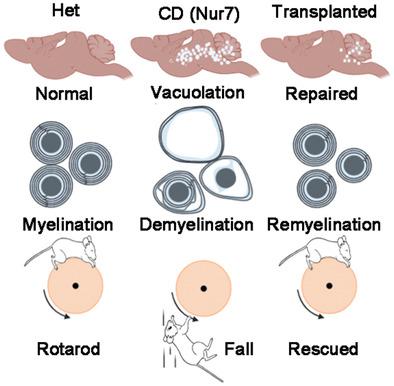Our official English website, www.x-mol.net, welcomes your feedback! (Note: you will need to create a separate account there.)
Cell‐Based Therapy for Canavan Disease Using Human iPSC‐Derived NPCs and OPCs
Advanced Science ( IF 15.1 ) Pub Date : 2020-10-29 , DOI: 10.1002/advs.202002155 Lizhao Feng 1 , Jianfei Chao 1 , E Tian 1 , Li Li 1 , Peng Ye 1 , Mi Zhang 1 , Xianwei Chen 1 , Qi Cui 1 , Guihua Sun 2 , Tao Zhou 1 , Gerardo Felix 1, 3 , Yue Qin 1 , Wendong Li 1 , Edward David Meza 1 , Jeremy Klein 1 , Lucy Ghoda 1 , Weidong Hu 4 , Yonglun Luo 5 , Wei Dang 6 , David Hsu 6 , Joseph Gold 6 , Steven A Goldman 7, 8 , Reuben Matalon 9 , Yanhong Shi 1
Advanced Science ( IF 15.1 ) Pub Date : 2020-10-29 , DOI: 10.1002/advs.202002155 Lizhao Feng 1 , Jianfei Chao 1 , E Tian 1 , Li Li 1 , Peng Ye 1 , Mi Zhang 1 , Xianwei Chen 1 , Qi Cui 1 , Guihua Sun 2 , Tao Zhou 1 , Gerardo Felix 1, 3 , Yue Qin 1 , Wendong Li 1 , Edward David Meza 1 , Jeremy Klein 1 , Lucy Ghoda 1 , Weidong Hu 4 , Yonglun Luo 5 , Wei Dang 6 , David Hsu 6 , Joseph Gold 6 , Steven A Goldman 7, 8 , Reuben Matalon 9 , Yanhong Shi 1
Affiliation

|
Canavan disease (CD) is a fatal leukodystrophy caused by mutation of the aspartoacylase (ASPA) gene, which leads to deficiency in ASPA activity, accumulation of the substrate N‐acetyl‐L‐aspartate (NAA), demyelination, and spongy degeneration of the brain. There is neither a cure nor a standard treatment for this disease. In this study, human induced pluripotent stem cell (iPSC)‐based cell therapy is developed for CD. A functional ASPA gene is introduced into patient iPSC‐derived neural progenitor cells (iNPCs) or oligodendrocyte progenitor cells (iOPCs) via lentiviral transduction or TALEN‐mediated genetic engineering to generate ASPA iNPC or ASPA iOPC. After stereotactic transplantation into a CD (Nur7) mouse model, the engrafted cells are able to rescue major pathological features of CD, including deficient ASPA activity, elevated NAA levels, extensive vacuolation, defective myelination, and motor function deficits, in a robust and sustainable manner. Moreover, the transplanted mice exhibit much prolonged survival. These genetically engineered patient iPSC‐derived cellular products are promising cell therapies for CD. This study has the potential to bring effective cell therapies, for the first time, to Canavan disease children who have no treatment options. The approach established in this study can also benefit many other children who have deadly genetic diseases that have no cure.
中文翻译:

使用人类 iPSC 衍生的 NPC 和 OPC 进行卡纳万病的细胞疗法
卡纳万病(CD)是一种致命性脑白质营养不良,由天冬氨酸酰化酶(ASPA)基因突变引起,导致ASPA活性缺陷、底物N-乙酰-L-天冬氨酸(NAA)积累、脱髓鞘和海绵状变性。脑。这种疾病既没有治愈方法也没有标准治疗方法。在这项研究中,开发了基于人类诱导多能干细胞 (iPSC) 的 CD 细胞疗法。通过慢病毒转导或 TALEN 介导的基因工程将功能性ASPA基因引入患者 iPSC 衍生的神经祖细胞 (iNPC) 或少突胶质细胞祖细胞 (iOPC),以生成 ASPA iNPC 或 ASPA iOPC。立体定向移植到 CD (Nur7) 小鼠模型后,植入的细胞能够以稳健和可持续的方式挽救 CD 的主要病理特征,包括 ASPA 活性缺陷、NAA 水平升高、广泛空泡形成、髓鞘形成缺陷和运动功能缺陷。方式。此外,移植的小鼠表现出更长的存活时间。这些基因工程患者 iPSC 衍生的细胞产品是有前途的 CD 细胞疗法。这项研究有可能首次为没有治疗选择的卡纳万病儿童带来有效的细胞疗法。这项研究中建立的方法也可以使许多其他患有无法治愈的致命遗传性疾病的儿童受益。
更新日期:2020-12-03
中文翻译:

使用人类 iPSC 衍生的 NPC 和 OPC 进行卡纳万病的细胞疗法
卡纳万病(CD)是一种致命性脑白质营养不良,由天冬氨酸酰化酶(ASPA)基因突变引起,导致ASPA活性缺陷、底物N-乙酰-L-天冬氨酸(NAA)积累、脱髓鞘和海绵状变性。脑。这种疾病既没有治愈方法也没有标准治疗方法。在这项研究中,开发了基于人类诱导多能干细胞 (iPSC) 的 CD 细胞疗法。通过慢病毒转导或 TALEN 介导的基因工程将功能性ASPA基因引入患者 iPSC 衍生的神经祖细胞 (iNPC) 或少突胶质细胞祖细胞 (iOPC),以生成 ASPA iNPC 或 ASPA iOPC。立体定向移植到 CD (Nur7) 小鼠模型后,植入的细胞能够以稳健和可持续的方式挽救 CD 的主要病理特征,包括 ASPA 活性缺陷、NAA 水平升高、广泛空泡形成、髓鞘形成缺陷和运动功能缺陷。方式。此外,移植的小鼠表现出更长的存活时间。这些基因工程患者 iPSC 衍生的细胞产品是有前途的 CD 细胞疗法。这项研究有可能首次为没有治疗选择的卡纳万病儿童带来有效的细胞疗法。这项研究中建立的方法也可以使许多其他患有无法治愈的致命遗传性疾病的儿童受益。





























 京公网安备 11010802027423号
京公网安备 11010802027423号